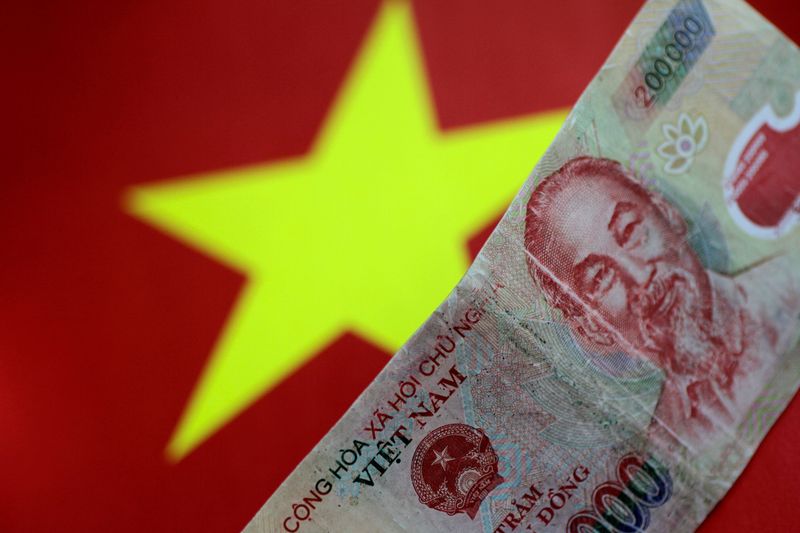Exclusive-Vietnam may widen dong trading band again to conserve FX reserves – source
2022.10.26 04:57
[ad_1]

© Reuters. FILE PHOTO: A Vietnam Dong note is seen in this illustration photo May 31, 2017. REUTERS/Thomas White/Illustration
HANOI (Reuters) – Vietnam is preparing to loosen its tight leash on the dong currency, including possibly widening its trading band with the U.S. dollar again, in order to conserve its shrinking currency reserves, a source with direct knowledge of the matter said on Wednesday.
The dong is a managed peg to the dollar and has fallen 8% this year, pressured by capital outflows as the U.S. Federal Reserve repeatedly raises rates to tame inflation.
The State Bank of Vietnam (SBV) has intervened to defend the currency, although it rarely discloses FX reserves data or the amount of dollars spent. Some market analysts estimate about $20 billion has been sold so far this year.
When the SBV last widened the band around its daily dong reference rate on Oct. 17 to 5% from 3% — which some traders likened to a de facto devaluation — the currency fell to the weak end in a sign of the heavy demand for dollars.
By 0324 GMT on Wednesday, the dong was down 0.04% to 24,855 per dollar. But on the black market, it was trading at a record low of 25,370 per dollar.
The source, who refused to be identified, said the country is willing to tolerate a further 1-1.5% dong devaluation against the dollar by year end.
Widening the band, which would allow the market to drive the currency lower without triggering so much FX reserves selling, was one possibility, the source said.
Other measures to cushion the dong, without exhausting FX reserves, were also being discussed, he said, without providing further details.
The timing of such moves was still under consideration, he added, but would likely be after next week’s Federal Reserve meeting where it is expect to deliver another hefty rate hike.
“The key measure for the SBV to stabilise the dong is still selling dollars and buying dong, but the SBV is not in a good position to do that now,” the source said.
SBV had no comment on the possible widening of the trading band, saying it would be in touch with relevant agencies.
Up until September, the dong was the most stable currency in the region, with the economy recording another quarter of strong growth and solid exports providing policymakers with plenty of hard currency to support it.
But October alone saw a 4% erosion in the dong’s value against the dollar, underperforming its peers in Asia.
Unlike its neighbours and global emerging market peers, Vietnam’s central bank only began to raise interest rates in recent weeks to combat inflation. It has now raised its policy rates twice in four weeks.
“Vietnam’s response to the global situation has not been so prompt. That’s why the dong is under so much pressure,” the source said.
The source said the SBV was trying to conserve its dollars as the country’s FX reserves had sunk to the International Monetary Fund’s recommended level, which is at least three months of imports.
Vietnam’s foreign reserves have fallen significantly since the start of the year, from the peak of $112.2 billion in January to $94.5 billion in August, according to a Fitch Solutions report citing IMF data.
Around $2 billion of foreign investment inflows in the form of existing loan contracts are expected next month, which could reduce the pressure on the currency.
“We believe that further policy tightening will be required to stabilise the situation,” said Bank of America (NYSE:) Securities’ ASEAN economist Mohamed Faiz Nagutha in a note to clients on Tuesday.
“This will likely take the form of another de-facto devaluation of the dong … and/or further rate hikes,” he said.
“We maintain our medium-term positive view on Vietnam, but policymakers need to draw important lessons from the current episode to modernise the monetary policy regime and make way for a more flexible exchange rate to act as a shock absorber.”
[ad_2]
Source link








